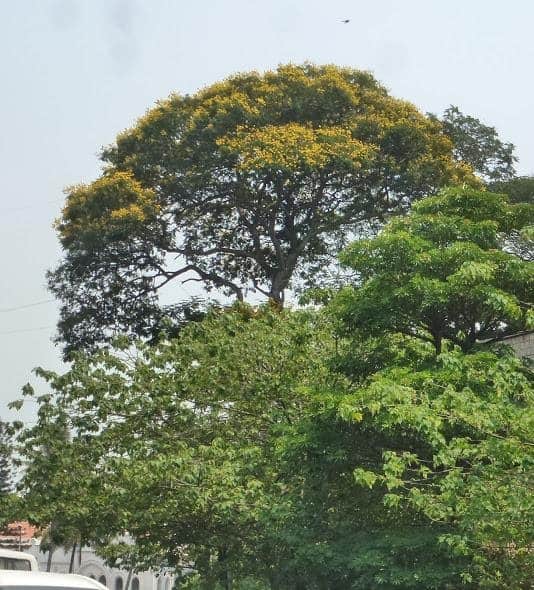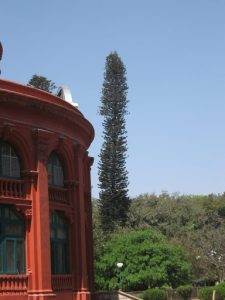Bengaluru may not be the Indian city with the most number of trees, but it certainly has a wide diversity of flowering and avenue trees. Our city also has many species that attain enormous size or height, such as the Akasha Mallige, Silver Oak, Aruacarias, Rain Trees and the African Tulip.
Some of these giants simply arrest our senses by their sheer size and majestic bearing as they stand guard over street corners, traffic islands or small lanes. What makes many of them unique is that they are rarely found in cities, and would be more at home in jungles.
We must be grateful to foresters of yesteryears who were bold to think out of the box and plant such saplings 50 or more years ago, against conventional wisdom. If you look carefully, you can locate these tree giants in your own area and keep a record of them for posterity.
Here is a look at some of these:
Ptreygota Alata, Malleshwaram 7th Main
Known popularly as Buddha’s Coconut, Pterygota Alata is commonly found in the forests of Western Ghats and Northeast, where it grows very tall indeed. For example, if you are on the way to Jog Falls, you can see some of them outside Talguppa Railway Station.
The fruits of this tree are hard and woody. In the right season, the fruit releases seeds that have a single wing so cleverly twisted that they float down spiralling exactly like a helicopter’s rotors. The tree’s flowers are rather indistinct.
The huge specimen on 7th Main is imposing, as this narrow road is lined by only medium-sized trees and rather small homes and apartments. There are a few more in Malleshwaram, possibly on the 18th or 17th Cross, but you will have to explore further.
The pavement outside IIM-B also had about 10 Buddha’s Coconuts, but of smaller size. These were mistakenly cut down by a BBMP contractor, under the impression that these had to make way for the Metro! Hopefully we can compensate for this after 2025, when Metro work is completed.
Senegal Lilac, 11th Cross Malleshwaram
You don’t need much guidance to see this tree. Walk upslope on 11th Cross from the Vyalikaval end. As you approach the Krishna temple on 11th Cross, you can’t miss it, on the left. A tall tree with a large billowing crown, and slender leaves 6-8 inches long.
This tree is 60-70 ft tall. In March, look for the amazing display of lilac flowers that seem to cover the entire crown. Get up close and you will observe the small pea-shaped pink flowers close together on spikes.

What could be Senegal Lilac or Lonchocarpus Sericeus – 11th Cross, Malleshwaram. Pic: S Nityananda
A word of disclaimer here – it is not at all easy to get an ID of this tree. Some have suggested that it could be from the Lonchocarpus genus, with origins in West Africa and Tropical South America. It’s a mystery what this tree is doing in Malleshwaram, but that indeed is our good fortune.
A word of caution: in case this is a lilac, the seeds and flowers are poisonous, so don’t try to taste it! (This doesn’t bother the various vendors on 11th Cross though, who operate from beneath this Goliath.)
Again, some have said that similar trees exist on other roads in this suburb, but you’ll have to do your own exploration here. There is one nearby, on the 10th Cross, but not so giant as this one.
Peltophorum Pterocarpum, Cubbon park
This is a common tree in Bengaluru. It has copper-coloured disc-like pods that carry seeds. It’s known for the dense shade it provides in our hot weather. The tree originates from Australia and is commonly known as the Copper Pod. It’s covered with bright yellow flowers in the summer.
The Cubbon Park specimen though is of outstanding height, maybe 70-80 ft, and is easily visible from Seshadri Road as you approach KR Circle by car, bus or walk. Look about two o’clock to the right, you will see it towering above everything else, about half a kilometer away. The tree is located behind the RBI buildings.

The impressive Copper Pod, seen from Seshadri Road. Pic: S Nityananda
Ficus – M N Krishna Rao Road, Basavanagudi
Sir MN Krishna Rao Road is a fairly inconspicuous road that runs radially from GS Madhava Rao Circle upto Lalbagh West Gate. It may be narrow and just about half a kilometer long, but has broad pavements on either side, and is a must-go for anyone who wants to see Bengaluru’s Ficus trees in all their glory.
Three outstanding specimens of Ficus family stand guard like giants, on this road – Ficus Religiosa (Peepal), Ficus Mysorensis and what may possibly be Ficus Cunninghami. Each has its own unique trunk, bark and leaf structure. In the right season, you can observe the different kinds of fruits they bring out.
They all have magnificent fluted trunks over 5 feet in diameter, and give a fabulous aura to this little-known street. They dominate the scene so much that you may well miss all the other trees on this road.
You can simply walk down MNK Road and feel the ambience these great, ancient trees provide. I myself had become curious about this road when I saw the giant crown of the Peepal tree as I stood in a Metro carriage that was approaching Lalbagh station.
Araucaria, Cubbon Park

Grand architecture – by man and by nature. Pic: S Nityananda
Perhaps Bengaluru’s tallest tree resides in Lalbagh – the over 150-year-old Araucaria Cooki – near the Glass House. This tree came from the faraway New Caledonia, an archipelago in the South Pacific Ocean.
It also has a number of companions of the same family in the vicinity. But one that stands out is the loner in Cubbon Park , which you can see as you walk anti-clockwise around the famed Seshadri Memorial Library at the heart of the park.
As you round the corner, this Araucaria arrests you with its stately and perhaps lonely presence. And that is what I have tried to capture in the picture at the right.
Perhaps Citizen Matters can get these trees tagged with info like Common Name, Botanical Name, Nativity Country and age if known.
Excellent report.Documenting such facts for the future helps always.Thank you